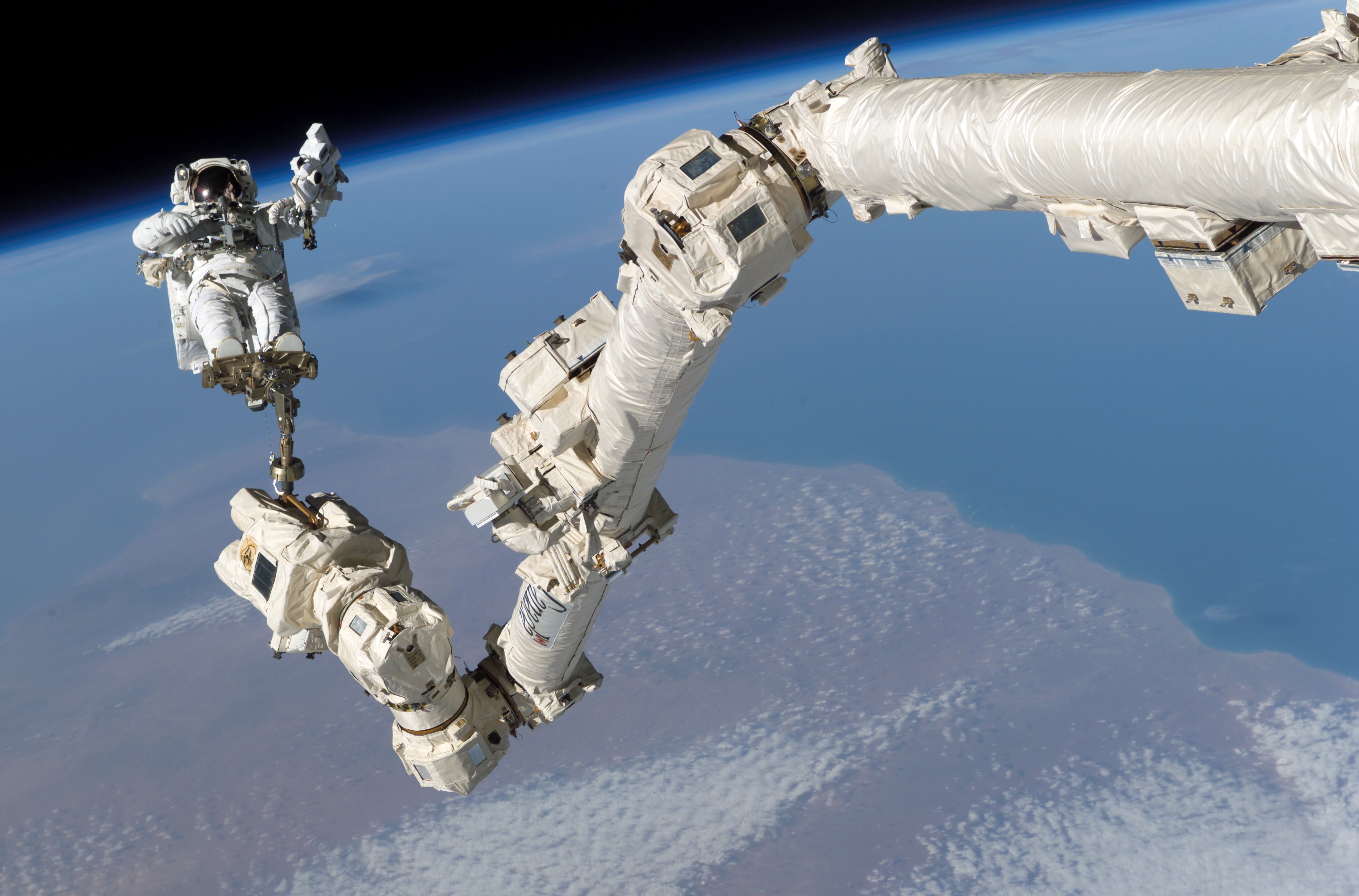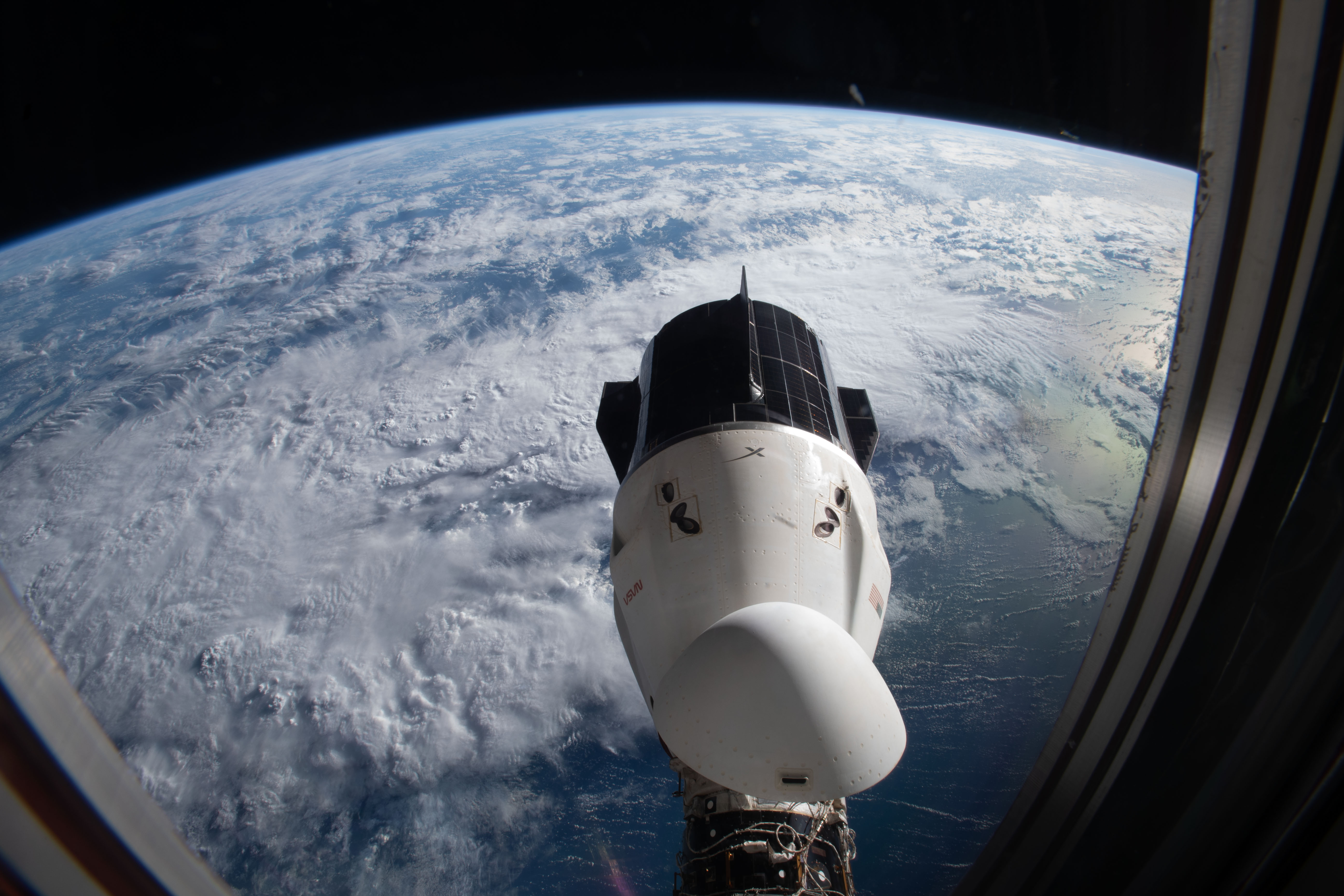|
Canadarm2
The Mobile Servicing System (MSS) is a robotic system on board the International Space Station (ISS). Launched to the ISS in 2001, it plays a key role in station assembly and maintenance; it moves equipment and supplies around the station, supports astronauts working in space, services instruments and other payloads attached to the ISS, and is used for external maintenance. Astronauts receive specialized training to perform these functions with the various systems of the MSS. The MSS is composed of three components: * the Space Station Remote Manipulator System (SSRMS), known as Canadarm2. * the Mobile Remote Servicer Base System (MBS). * the Dextre, Special Purpose Dexterous Manipulator (SPDM, also known as "Dextre" or "Canada hand"). The system can move along rails on the Integrated Truss Structure on top of the US-provided Mobile Transporter cart, which hosts the MRS Base System. The system's control software was written in the Ada (programming language), Ada 95 programming ... [...More Info...] [...Related Items...] OR: [Wikipedia] [Google] [Baidu] |
Power Data Grapple Fixture
Grapple fixtures are used on spacecraft or other objects to provide a secure connection for a Articulated robot, robotic arm. North America The fixtures allowed the Space Shuttle, Space Shuttle's Canadarm (also known as the Shuttle Remote Manipulator System, or SRMS) to safely grapple large objects (e.g. ISS components, or satellites e.g. Hubble Space Telescope, HST). They currently do the same for the International Space Station's Mobile Servicing System#Canadarm2, Space Station Remote Manipulator System (SSRMS) (also known as Canadarm2) and the Kibo (ISS module)#Remote Manipulator System, Japanese Experiment Module Remote Manipulator System (JEMRMS). The grapple fixtures are flat in appearance, with a central grapple pin topped with a sphere which the snares in the end of the arms latch on to. They use three "ramps" that help guide the robotic arm correctly onto the grapple fixture. Development The North American grapple fixture was developed at Spar Aerospace in the 1970s. It ... [...More Info...] [...Related Items...] OR: [Wikipedia] [Google] [Baidu] |
International Space Station
The International Space Station (ISS) is a large space station that was Assembly of the International Space Station, assembled and is maintained in low Earth orbit by a collaboration of five space agencies and their contractors: NASA (United States), Roscosmos (Russia), European Space Agency, ESA (Europe), JAXA (Japan), and Canadian Space Agency, CSA (Canada). As the largest space station ever constructed, it primarily serves as a platform for conducting scientific experiments in microgravity and studying the space environment. The station is divided into two main sections: the Russian Orbital Segment (ROS), developed by Roscosmos, and the US Orbital Segment (USOS), built by NASA, ESA, JAXA, and CSA. A striking feature of the ISS is the Integrated Truss Structure, which connect the station’s vast system of solar panels and Spacecraft thermal control, radiators to its pressurized modules. These modules support diverse functions, including scientific research, crew habitation, ... [...More Info...] [...Related Items...] OR: [Wikipedia] [Google] [Baidu] |
Dextre
Dextre, also known as the Special Purpose Dexterous Manipulator (SPDM), is a two-armed robot, or telemanipulator, which is part of the Mobile Servicing System on the International Space Station (ISS), and does repairs that would otherwise require astronauts to do spacewalks. It was launched on March 11, 2008, on the mission STS-123. Dextre is a part of Canada's contributions to the ISS and was named to represent its dexterous nature. Dextre is the newest of three Canadian robotic arms used on the ISS, preceded by the Space Shuttle's Canadarm and the large Canadarm2. Dextre was designed and manufactured by MDA.CanWest News Service'"Canada Hand" successfully installed', 15 March 2006 In the early morning of February 4, 2011, Dextre completed its first official assignment which consisted of unpacking two pieces for Kounotori 2 while the on-board crew was sleeping. [...More Info...] [...Related Items...] OR: [Wikipedia] [Google] [Baidu] |
Canadarm2 Latching End Effector And Joints (ISS052e000402)
Canadarm or Canadarm1 (officially Shuttle Remote Manipulator System or SRMS, also SSRMS) is a series of robotic arms that were used on the Space Shuttle orbiters to deploy, manoeuvre, and capture payloads. After the Space Shuttle ''Columbia'' disaster, the Canadarm was always paired with the Orbiter Boom Sensor System (OBSS), which was used to inspect the exterior of the shuttle for damage to the thermal protection system. Development In 1969, Canada was invited by the National Aeronautics and Space Administration (NASA) to participate in the Space Shuttle program. At the time what that participation would entail had not yet been decided but a manipulator system was identified as an important component. Canadian company DSMA ATCON had developed a robot to load fuel into CANDU nuclear reactors; this robot attracted NASA's attention. In 1975, NASA and the Canadian National Research Council (NRC) signed a memorandum of understanding that Canada would develop and construc ... [...More Info...] [...Related Items...] OR: [Wikipedia] [Google] [Baidu] |
STS-100
STS-100 was a Space Shuttle mission to the International Space Station (ISS) flown by Space Shuttle '' Endeavour''. STS-100 launch on 19 April 2001, and installed the ISS Canadarm2 robotic arm. Crew Mission highlights The highest priority objectives of the flight were the installation, activation and checkout of the Canadarm2 robotic arm on the station. The arm - manufactured by MDA Space Missions under contract of the Canadian Space Agency and NASA, went into operation on 28 April 2001. It was critical to the capability to continue assembly of the International Space Station. The arm was also necessary to attach a new airlock to the station on the subsequent shuttle flight, mission STS-104. The final component of the Canadarm is the Mobile Base System (MBS), which was installed on board the station during the STS-111 flight. Other major objectives for ''Endeavours mission were to berth the ''Raffaello'' logistics module to the station, activate it, transfer cargo betwe ... [...More Info...] [...Related Items...] OR: [Wikipedia] [Google] [Baidu] |
Integrated Truss Structure
The Integrated Truss Structure (ITS) of the International Space Station (ISS) consists of a linear arranged sequence of connected trusses on which various unpressurized components are mounted such as logistics carriers, radiators, ISS Solar Arrays, solar arrays, and other equipment. It supplies the ISS with a Spacecraft bus, bus architecture. It is approximately 110 meters long and is made from aluminium and stainless steel. Truss components All truss components were named after their planned end-positions: Z for zenith, S for starboard and P for port, with the number indicating the sequential position. The S0 truss might be considered a misnomer, as it is mounted centrally on the zenith position of ''Destiny'' and is neither starboard nor port side. Manufacturing ISS truss segments were Manufacturing of the International Space Station, fabricated by Boeing in its facilities at Huntington Beach, California (formerly McDonnell Douglas), Michoud Assembly Facility in New Orlean ... [...More Info...] [...Related Items...] OR: [Wikipedia] [Google] [Baidu] |
Canadian Space Agency
The Canadian Space Agency (CSA; ) is the national space agency of Canada, established in 1990 by the ''Canadian Space Agency Act''. The President of the Canadian Space Agency, president is Lisa Campbell (civil servant), Lisa Campbell, who took the position on September 3, 2020. The agency is responsible to the Minister of Innovation, Science and Industry, minister of innovation, science and industry. The CSA's headquarters are located at the John H. Chapman Space Centre in Longueuil, Quebec. The agency also has offices in Ottawa, Ontario, and small liaison offices in Houston, Washington, D.C., Washington, and Paris. History The origins of the Canadian upper atmosphere and space program can be traced back to the end of the World War II, Second World War. Between 1945 and 1960, Canada undertook a number of small launcher and satellite projects under the aegis of defence research, including the development of the Black Brant (rocket), Black Brant rocket as well as series of advance ... [...More Info...] [...Related Items...] OR: [Wikipedia] [Google] [Baidu] |
H-II Transfer Vehicle
The H-II Transfer Vehicle (HTV), also called , is an Expendable launch system, expendable Japanese Cargo spacecraft, automated cargo spacecraft designed for International Space Station (ISS) resupply missions, particularly the Kibo (ISS module), ''Kibō'' Japanese Experiment Module (JEM). Development of the spacecraft began in the early 1990s and the HTV's first mission, HTV-1, was launched on 10September 2009 on an H-IIB launch vehicle. The name ''Kounotori'' was chosen because "a white stork carries an image of conveying an important thing (a baby, happiness, and other joyful things), therefore, it precisely expresses the HTV's mission to transport essential materials to the ISS". The HTV is crucial for ISS resupply, especially after the retirement of the Space Shuttle, as it's the only vehicle capable of transporting large International Standard Payload Racks (ISPR) and disposing of old ones within the ISS's US Orbital Segment. The final HTV mission, Kounotori 9, was laun ... [...More Info...] [...Related Items...] OR: [Wikipedia] [Google] [Baidu] |
Extra-vehicular Activity
Extravehicular activity (EVA) is any activity done by an astronaut in outer space outside a spacecraft. In the absence of a breathable Earthlike atmosphere, the astronaut is completely reliant on a space suit for environmental support. EVA includes spacewalks and lunar or planetary surface exploration (commonly known from 1969 to 1972 as moonwalks). In a stand-up EVA (SEVA), an astronaut stands through an open hatch but does not fully leave the spacecraft. EVAs have been conducted by the Soviet Union/Russia, the United States, Canada, the European Space Agency and China. On March 18, 1965, Alexei Leonov became the first human to perform a spacewalk, exiting the Voskhod 2 capsule for 12 minutes and 9 seconds. On July 20, 1969, Neil Armstrong became the first human to perform a moonwalk, outside his lunar lander on Apollo 11 for 2 hours and 31 minutes. In 1984, Svetlana Savitskaya became the first woman to perform a spacewalk, conducting EVA outside the Salyut 7 space stati ... [...More Info...] [...Related Items...] OR: [Wikipedia] [Google] [Baidu] |
SpaceX Dragon
Dragon is a family of spacecraft developed and produced by American private space transportation company SpaceX. The first variant, later named SpaceX Dragon 1, Dragon 1, flew 23 cargo missions to the International Space Station (ISS) between 2010 and 2020 before retiring. Design of this version, not designed to carry astronauts, was funded by NASA with $396 million awarded through the Commercial Orbital Transportation Services program and contracted to ferry cargo under the Commercial Resupply Services (CRS) program. An improved version, the SpaceX Dragon 2, Dragon 2, was introduced in 2019 and has both crewed and cargo versions. The first un-crewed flight test (Crew Dragon Demo-1, Demo-1) took place in March 2019, followed by a crewed flight test (Crew Dragon Demo-2, Demo-2) in May 2020. Since those flight tests, the Crew Dragon has become one of the primary spacecraft ferrying crew to and from the ISS. While the Cargo Dragon continues to carry cargo under the CRS program. S ... [...More Info...] [...Related Items...] OR: [Wikipedia] [Google] [Baidu] |








